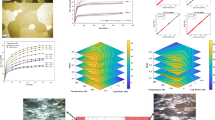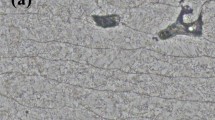Abstract
An accurate processing map for a metal provides a means of attaining a desired microstructure and required shape through thermo-mechanical processing. To construct such a map, the isothermal flow stress, σiso, is required. Conventionally, the non-isothermal flow stress measured by experiment is corrected to σiso using whole-temperature-range linear interpolation (WRLI) or partial-temperature-range linear interpolation (PRLI). However, these approaches could incur significant errors if the non-isothermal flow stress exhibits a non-linear relationship with the temperature. In this study, an artificial neural network (ANN) model was applied to correct the non-isothermal flow stress in 10 wt% Cr steel, which exhibits a non-linear temperature dependence within a target temperature range of 750–1250 °C. Processing maps were constructed using σiso corrected by applying the WRLI, PRLI, and ANN approaches, respectively, and were then compared with the actual microstructures. The WRLI approach produced the highest minimum error of σiso (17.2%) and over-predicted the shear-band formation. The PRLI approach reasonably predicted the microstructural changes, but the minimum error for σiso (8.9%) was somewhat high. The ANN approach not only realized the lowest minimum error of σiso (~ 0%), but also effectively predicted the microstructural changes.









Similar content being viewed by others
References
H.L. Gegel, in Computer Simulation in Materials Science, ed. by R.J. Arsenault, J.R. Beeler, D.M. Easterling (ASM, Metals Park, 1987), p. 291
J.C. Malas, V. Seetharaman, JOM 44, 8 (1992)
S.V.S.N. Murty, B.N. Rao, Mater. Sci. Eng. A 254, 76 (1998)
S.L. Semiatin, G.D. Lahoti, Metall. Trans. A 12, 1705 (1981)
Y.V.R.K. Prasad, K.P. Rao, S. Sasidhara, Hot Working Guide, 2nd edn. (ASM International, Ohio, 2015), pp. 1–30
G.R. Johnson, W.H. Cook, in Proceedings of Seventh International Symposium on Ballistics. A Constitutive Model and Data for Metals subjected to Large Strains, High Strain Rates and High Temperatures (The Hague, The Netherlands, 1983)
A.S. Khan, S. Huang, Int. J. Plasticity 8, 397 (1992)
A.S. Khan, R. Liang, Int. J. Plasticity 15, 1089 (1999)
M.J. Kim, H.J. Jeong, J.W. Park, S.T. Hong, H.N. Han, Met. Mater. Int. 24, 42 (2018)
F. Kabirian, A.S. Khan, A. Pandey, Int. J. Plasticity 55, 232 (2014)
H. Mecking, U.F. Kocks, Acta Metall. 29, 1865 (1981)
P.S. Follansbee, G.T. Gray III, Metall. Trans. A 20, 863 (1989)
S. Nemat-Nasser, J.B. Isaacs, Acta Mater. 45, 907 (1997)
C.H. Park, S.G. Hong, C.S. Lee, Mater. Sci. Eng. A 528, 1154 (2011)
I. Yoo, J. Park, S. Choe, Korean J. Met. Mater. 34, 973 (1996)
X. Yang, H. Guo, Z. Yao, J. Mater. Res. 31, 2863 (2016)
N.S. Reddy, Y.H. Lee, C.H. Park, C.S. Lee, Mater. Sci. Eng. A 492, 276 (2008)
G. Ji, F. Li, Q. Li, H. Li, Z. Li, Mater. Sci. Eng. A 528, 4774 (2011)
P.S. Robi, U.S. Dixit, J. Mater. Process Technol. 142, 289 (2003)
S. Mandal, P.V. Sivaprasad, S. Venugopal, K.P.N. Murthy, Appl. Soft Comput. 9, 237 (2009)
J. Zhao, H. Ding, W. Zhao, M. Huang, D. Wei, Z. Jiang, Comput. Mater. Sci. 92, 47 (2014)
Y. Zhu, W. Zeng, Y. Sun, F. Feng, Y. Zhou, Comput. Mater. Sci. 50, 1785 (2011)
B.H. Lee, N.S. Reddy, J.T. Yeom, C.S. Lee, J. Mater. Process Tech. 187–188, 766 (2007)
C.H. Park, Y.G. Ko, J. Park, C.S. Lee, Mater. Sci. Eng. A 496, 150 (2008)
Acknowledgements
This study was supported by a grant (2013025839) from Doosan Heavy Industries & Construction, Republic of Korea. Author N. S. Reddy greatly acknowledges for the support of research group promotion, Gyeongsang National University, 2014.
Author information
Authors and Affiliations
Corresponding author
Rights and permissions
About this article
Cite this article
Park, C.H., Cha, D., Kim, M. et al. Neural Network Approach to Construct a Processing Map from a Non-linear Stress–Temperature Relationship. Met. Mater. Int. 25, 768–778 (2019). https://doi.org/10.1007/s12540-018-00225-8
Received:
Accepted:
Published:
Issue Date:
DOI: https://doi.org/10.1007/s12540-018-00225-8




